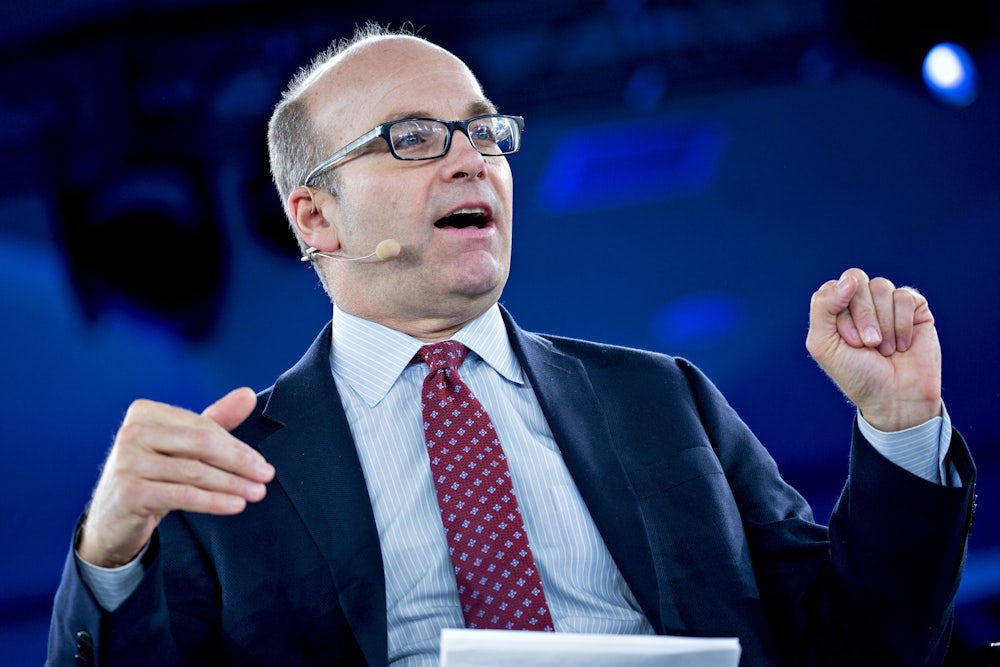In 1936, The New Yorker’s Wolcott Gibbs published a celebrated profile of Henry Luce, co-founder with Briton Hadden of Time magazine. The piece was written entirely in parodic Time-ese. In those days Time’s house style favored Homeric epithets, portmanteau neologisms, and sentences where verbs, adverbs, and adjectives were yanked violently from their customary place and shoved in front of proper nouns. Here’s Gibbs’s most famous paragraph:
“Great word! Great word!” would crow Hadden, coming upon “snaggle-toothed,” “pig-faced.” Appearing already were such maddening coagulations as “cinemaddict,” “radiorator.” Appearing also were first gratuitous invasions of privacy. Always mentioned as William Randolph Hearst’s “great & good friend” was Cinemactress Marion Davies, stressed was the bastardy of Ramsay MacDonald, the “cozy hospitality” of Mae West. Backward ran sentences until reeled the mind.
Enough traces of what came to be called “Timestyle” linger in newswriting today (though not so much anymore in Time itself) that Gibbs’s parody probably strikes a familiar note even to younger readers. My own pet peeve is the usage “Said Joe: ‘I’m hungry,’” in lieu of “‘I’m hungry,’ said Joe.”
Now a new newswriting dialect is spreading like a communicable disease across the internet, one that’s impossible to write about without, like Gibbs, aping it:
Axios Chiefs Pen Style Guide
Shoot Me Now: Jim VandeHei, Mike Allen, and Roy Schwartz of Axios are trying to get the whole country to write in the same grocery-list style as Axios, through publication of Smart Brevity: The Power of Saying More With Less.
The big picture: When the three Politico defectors founded Axios in 2016, VandeHei and Co. hoped to sell high-priced trade news to corporate and government subscribers. But that market was glutted already by Politico and Bloomberg. So instead Axios created AxiosHQ, which charges corporations a reported $10,000 and up to teach them how to write like Axios.
- Axios was purchased in August by Cox Enterprises for $525 million.*
- VandeHei and Co. kept a majority stake in Axios HQ. Smart Brevity is a marketing tool for Axios HQ.
- There’s already a perfectly good style guide called The Elements of Style by William Strunk Jr. and E.B. White. White was a journalist, and The Elements of Style preaches journalistic brevity above all else.
- Funnily enough, The Elements of Style is shorter (132 pages—and that’s padded out with Maira Kalman’s illustrations!—versus 218 for Smart Brevity). Plus, as Colin Dickey noted in his September 15 review of Smart Brevity in TNR, “a book that advises ‘skip the anecdotes’” turns out to include a lot of tedious anecdotes, principally about VandeHei, who’s a nice guy but loves to hear himself talk.
- Axios gets some pretty good scoops, but the site’s abbreviated house style, intended to serve multitasking corporate fatheads, makes it harder rather than easier to understand than regular old discursive prose. Smart Brevity is loaded with “before-after” examples in which the “before” phrasing is hilariously superior to the “after” rendering in the supposedly better Smart Brevity style.
Zoom in: To muscle onto the New York Times Best-Seller List, Axios management sent an internal memo (written, of course, in Axios-ese) urging staffers to purchase six copies apiece and expense it.
Why it matters: As with Timestyle, Axios-ese is spreading like a noxious weed to other publications, doing violence to the mother tongue, dumbing down the news, and, ironically, impeding communication.
Since Axios-ese really does impede communication, let me set aside the parody format and proceed in a more traditional expository style.
Like a lot of things, the Axios dialect emerged from a good idea that spun madly out of control. At Politico, where I was an editor for six years, it was VandeHei who came up with the insight (or so I was told) that most spot-news stories consisted of two or three short paragraphs that conveyed the necessary new information, followed by 12 paragraphs of filler (what journalists call “B matter”). At Politico Pro, the paywalled trade-news division where I worked, such filler was especially unnecessary because subscribers to each topic-focused “vertical” (mine was about labor) already possessed expertise in the general subject. So we tried to make spot-news stories no longer than would occupy a single iPhone screen without scrolling down. Those who wanted to dig deeper could click on embedded links that took them to government documents and other background material.
VandeHei’s problem after he left Politico was that he’d already had his valuable insight, and Politico was making profitable use of it. He needed a second act. So at Axios, VandeHei took that insight and pushed it and stretched it to the point of self-parody. The grocery-list format was born.
One of the problems with Axios-ese is that it doesn’t take into account that news isn’t read but skimmed, a phenomenon that long predates the World Wide Web. “People don’t read the morning newspaper,” wrote Tom Wolfe, paraphrasing Marshall McLuhan, in 1975. “They slip into it like a warm bath.” What Wolfe meant was that readers didn’t typically engage in critical thinking while reading the newspaper because they were skimming through it too quickly. If you have a newspaper-reading habit you have a skimming habit, whether you read on paper or online.
Now along comes VandeHei to compress the news with juiced-up hyperbole and bullet points and “what’s next” and (most annoyingly) “be smart,” and the goddamned thing can’t be skimmed because it’s already been skimmed for you—pre-chewed, if you will—by the writer. Which means you have to slow down. Skim an Axios story, and it will fly past so quickly you’ll have no idea what it says. You have to read carefully to grasp its basic meaning. Then you have to waste even more time trying to figure out how much to discount for bullshit hype. Sometimes I have to read an Axios piece two or three times to understand what it says. A New York Times story I can digest with a single quick skim.
There are other practical problems with the format, which I learned during my last months at Politico (my vertical wasn’t pulling in enough revenue and eventually got shut down) as we began to experiment with a news template that nobody was allowed to call an Axios knockoff because it so obviously was just that. If you oblige your reporter to include subheads like “what’s next” and “why it matters” in every story, then you’re obliging that reporter to say what’s next and why it matters. And with an extremely fast turnaround for these short spot-news stories—gotta beat Bloomberg!—there’s a good chance your reporter doesn’t have time to find out what’s next and why it matters. So the reporter produces some mumbo-jumbo that can’t be proven wrong and wastes the reader’s time just to adhere to a rigid template.
Axios-ese strikes me as particularly unsuited to corporate communication, which for better or worse is packed deliberately with euphemism and indirection and exaggerated diplomacy. I don’t doubt that corporate chiefs want to receive memos that are shorter and more direct, but they don’t want to write memos in that style, and neither do their underlings. Here’s what the authors of Smart Brevity describe as a “simple work update,” before and after they’ve improved it.
Before:
John—we decided after lots of meetings and endless deliberation to shrink Monday meetings to just the core management team. You know this has been a source of great frustration for many, especially with the size of the group growing so fast.
Nobody, the authors say, “wants to wade through that mess to realize the point.”
After:
UPDATE: Shrinking Monday meetings to core management team only.
This is described as putting the audience, i.e. John, first. The Axiosified version certainly conveys the information faster, but it presumes that John, whose job sounds like it could be hanging by a thread, is an android with no feelings. What the Axios-ese version communicates can be reduced still further to its nub:
Fuck you, John.
The final reason to resist creeping Axios-ification is the same reason Gibbs had to parody Timestyle. It’s just ugly. Expository English is beautiful, or can be. Axios-speak is hideous, and it can’t be anything else. I don’t crave good discursive English only in literary fiction or a New Yorker essay. I crave it in instruction manuals (where it’s never present), cooking recipes (which have lately gotten clearer, thank goodness), and, yes, the news. Lucidity and attention to detail aren’t just aesthetic values; they make it easier to set up your TV, cook your soufflé, or understand the world around you.
The best Axios story I ever read was a Jonathan Swan piece about Trump’s second-term plan to gut the civil service. Swan told the story very simply, walking the reader through detail after detail. It was much longer than the usual Axios piece, which was appropriate to the material. But what I liked best about Swann’s piece was that it wasn’t written in that godawful Axios style. It was written in plain English.
* Correction: An earlier version of this article stated erroneously that Cox bought Axios HQ along with Axios.






